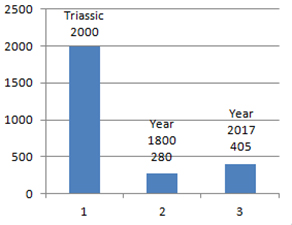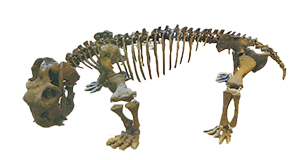Abundant life had once flourished here. But the Mesozoic era dawned over the wreckage of a world. Extinction kills every member of a species. But the damage was far worse.
Over half of all the biological families were gone, and 83% of genera. The Permian extinction had abruptly wiped out 96% of all ocean species, 70% of land species, and most insects. Ecosystems were dismembered. No coal seams would be forming in the world-wide deserts that remained. For ten million years, the tattered orphaned survivors would slowly recover in an inhospitable, low-oxygen environment poisoned by carbon dioxide at six times the modern day levels. The average temperature had jumped by 17 degrees Fahrenheit. Acidic oceans dissolved the skeletons of corals and the shells of ammonites, and the seas had become foul and sulfurous.
What force caused this destruction? A huge meteor impact? Massive volcanic eruptions? Climate change? The mystery is unsolved. But as today's Earth teeters in climate instability, the Triassic world is a compelling reminder of how fragile life can be.
A precious few of the mammal-like synapsids survived. Lystrosaurus was a burrowing, woodchuck-sized Therapsid that dominated the early recovery of land animals.
But as the impoverished ecology of the Triassic was slowly rebuilt, hostile conditions would favor a more reptilian creature -- turning the Mesozoic Era into the "The Age of Dinosaurs." |
|
Triassic sandstone from the American Southwest shown above. Time has worn away Tennessee's own Triassic landscapes..
 Atmospheric CO2 (in parts per million) rose dramatically after the Permian Extinction. Atmospheric CO2 (in parts per million) rose dramatically after the Permian Extinction.
 Lystrosaurus is the most common land animal recovered from early Triassic. This tough mammal-like herbivore inhabited a barren landscape with simplified ecosystems. Lystrosaurus is the most common land animal recovered from early Triassic. This tough mammal-like herbivore inhabited a barren landscape with simplified ecosystems.
|